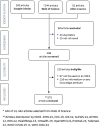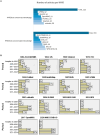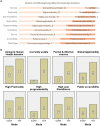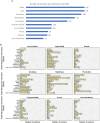Knowledge attributes of public health management information systems used in health emergencies: a scoping review
- PMID: 40191143
- PMCID: PMC11969037
- DOI: 10.3389/fpubh.2024.1458867
Knowledge attributes of public health management information systems used in health emergencies: a scoping review
Abstract
Introduction: Learning from public health emergencies has not always been possible due to suboptimal knowledge accrual from previous outbreaks. This study described the knowledge attributes of Health Management Information Systems (HMIS) that are currently used during health emergencies. It aims to inform the development of a "nuggets of knowledge" (NoK) platform to support agile decision-making and knowledge continuity following health emergencies.
Methods: A search was conducted on the Web of Science and Google Scholar, with no date restriction for articles that conveniently selected 13 HMIS and their knowledge attributes. Proportions were used to summarize HMIS distribution by countries' World Bank income status. Thematic content analysis was used to describe knowledge attributes of HMIS based on the knowledge attributes of Holsapple et al.
Results: Seven of the 13 HMIS contained tacit knowledge; the 7 HMIS were predominantly used in higher-income settings and developed after explicit knowledge containing HMIS. More HMISs that contained tacit knowledge were currently usable, universal, programmable, user-friendly, and relied on informal information sources than HMIS that contained explicit knowledge HMIS. Tacit and explicit knowledge containing HMIS were equally practical, accessible, and domain-oriented.
Conclusion: HMIS should continuously capture both tacit and explicit knowledge that is actionable and practical in HMIS, user-friendly, programmable, and accessible to persons in all geographical settings. HMIS that contain tacit knowledge have more favorable attributes than those that contain explicit knowledge, but they may not be available to all emergency responders globally, a distribution that may change as newer low-cost technologies become available. Future research should investigate the impact of the NoK platform on public health emergency management.
Keywords: experiential knowledge; health emergencies; knowledge dimensions; knowledge management systems; tacit knowledge.
Copyright © 2025 Burmen, Brennan, Samaila, Bell, Vente and Mayigane.
Conflict of interest statement
The authors declare that the research was conducted in the absence of any commercial or financial relationships that could be construed as a potential conflict of interest.
Figures






References
-
- Centers for Disease Control and Prevention. History of Ebola disease outbreaks (2023). Available at: https://www.cdc.gov/vhf/ebola/history/chronology.html (Accessed 15 November, 2023).
-
- World Health Organization . Ebola virus disease (2023). Available at: https://www.who.int/health-topics/ebola#tab=tab_1 (Accessed 15 November, 2023).
-
- United Nations Office for the Coordination of Humanitarian Affairs (OCHA) . How the Ebola response failed the people of DRC. (2020). Available at: https://iris.who.int/bitstream/handle/10665/70863/WHO_CDS_CSR_GAR_2003.1... (Accessed 15 November, 2023).
-
- World Health Organization . Consensus document on the epidemiology of severe acute respiratory syndrome (SARS) (2003). Available at: https://www.who.int/publications/i/item/consensus-document-on-the-epidem... (Accessed 15 November, 2023).
Publication types
MeSH terms
Grants and funding
LinkOut - more resources
Full Text Sources

